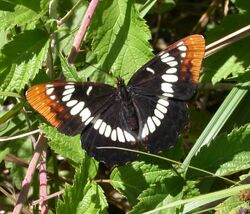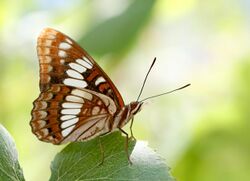Biology:Lorquin's admiral
| Lorquin's admiral | |
|---|---|

| |
| Scientific classification | |
| Domain: | Eukaryota |
| Kingdom: | Animalia |
| Phylum: | Arthropoda |
| Class: | Insecta |
| Order: | Lepidoptera |
| Family: | Nymphalidae |
| Genus: | Limenitis |
| Species: | L. lorquini
|
| Binomial name | |
| Limenitis lorquini (Boisduval, 1852)
| |
| Synonyms | |
| |

Lorquin's admiral (Limenitis lorquini) is a butterfly in the Nymphalinae subfamily. The butterfly is named after Pierre Joseph Michel Lorquin, a French naturalist who came to California from France during the Gold Rush, and made important discoveries on the natural history of the terrain.[1]
Description
The Lorquin's admiral has brown-black wings, each with a row of white spots across it. Its forewings have orange tips. Wingspan: 47 to 71 mm; females are generally larger than males.[2]
Distribution and habitat
The Lorquin's admiral can mostly be found across the Upper Sonoran to the Canadian Zone, east to western Montana and Idaho. Known areas include southern British Columbia (including Vancouver Island, north of Emerald Lake), and Cypress Hills in southwestern Saskatchewan as well as southwestern Alberta. The butterfly resides mostly in forest edges, mountain canyons, parks, streamsides, fencerows, orchards, and groves of cottonwood and poplar. Usually the butterflies feed on California buckeye, yerba santa, privet, bird droppings, and dung.[3] They are extremely territorial and will attack any intruders into their habitat, including large birds.
Larvae
Larvae are usually yellow with a patch of white on the back. Eggs are laid near or on the tips of leaves. Common trees that the larvae feed on include willow (Salix), poplar, cherry (Prunus), cottonwood (Populus), and an assortment of orchard trees, including cherry, apple, and plum.
Flight season
The Lorquin's admiral usually flies around April to October, though it depends on the region. Butterflies in northern areas tend to have one brood a year (usually between June and August) whereas southern butterflies (mainly in California) tend to have multiple broods.
Similar species
- California sister butterfly (Adelpha bredowii californica)
- Weidemeyer's admiral (L. weidemeyerii)
- White admiral (L. arthemis)
References
- ↑ "Lorquin's Admiral". lensjoy.com. http://www.lensjoy.com/gallery/41.htm.
- ↑ Canada, Agriculture and Agri-Food Canada;Government of. "Butterflies of Canada - Lorquin's Admiral (Limenitis lorquini) (Boisduval, 1852)". http://www.cbif.gc.ca/spp_pages/butterflies/species/Lorquin'sAdmiral_e.php.
- ↑ "Butterflies of Oregon -- Limenitis lorquini". Archived from the original on 2005-11-13. https://web.archive.org/web/20051113134236/http://www.npwrc.usgs.gov/resource/distr/lepid/bflyusa/or/26.htm. Retrieved 2006-02-09.
Further reading
- Glassberg, Jeffrey Butterflies through Binoculars: The West (2001)
- Guppy, Crispin S. and Shepard, Jon H. Butterflies of British Columbia (2001)
- James, David G. and Nunnallee, David Life Histories of Cascadia Butterflies (2011)
- Pelham, Jonathan Catalogue of the Butterflies of the United States and Canada (2008)
- Pyle, Robert Michael The Butterflies of Cascadia (2002)
External links
- Raising Butterflies
- Butterflies of Oregon
- Lorquin's Admiral, Butterflies of Canada
- Butterflies and Moths of North America - Limenitis lorquini
- Butterflies of America - Limenitis lorquini
Wikidata ☰ Q2533699 entry
 |

